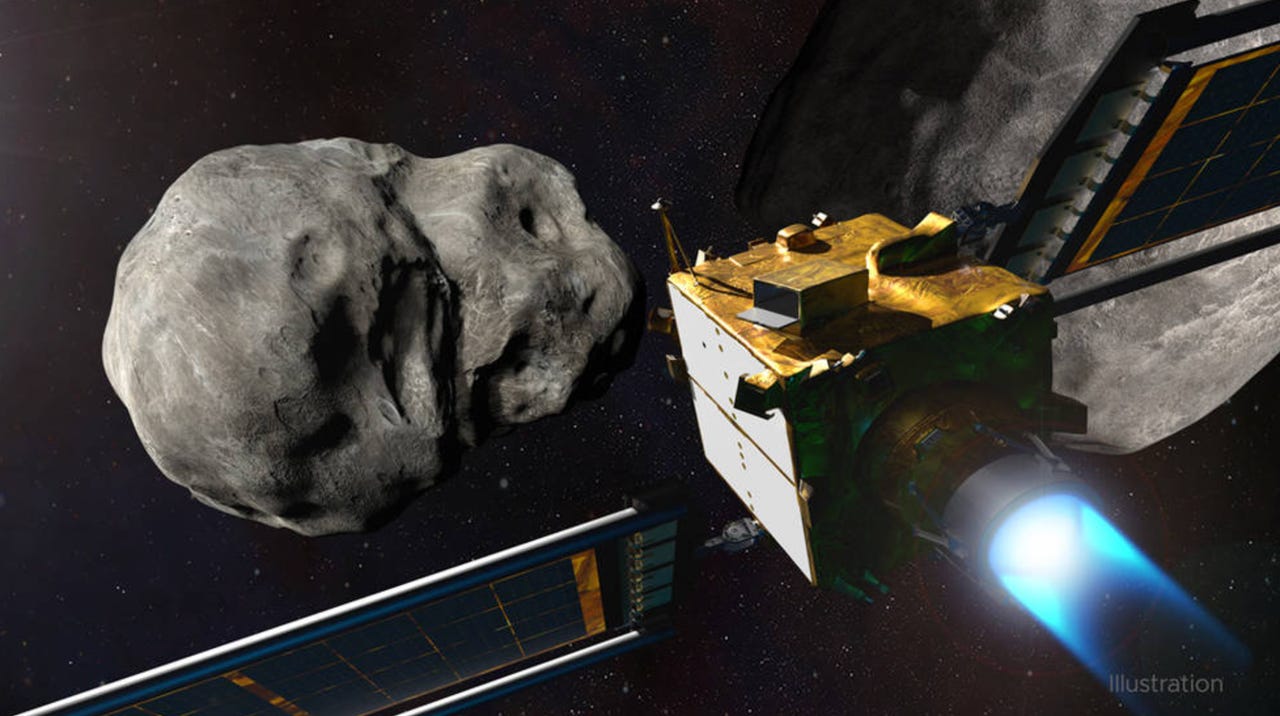































 Image: NASA
Image: NASA NASA has completed its first ever attempt to shift an asteroid as part of its planetary defense strategy.
NASA's DART probe -- a.k.a. the Double Asteroid Redirection Test -- was taking aim at Dimorphos, a smaller "egg-shaped" asteroid orbiting its much larger companion Didymos. Neither posed a threat to Earth, but NASA used DART to demonstrate that striking Dimorphos was a viable mitigation technique should it discover a similar body on an Earthbound trajectory.
As NASA Administrator Bill Nelson said, this international collaboration "turned science fiction into science fact, demonstrating one way to protect Earth."
Also:NASA's Perseverance rover continues its hunt for ancient life on Mars
The Dart probe impacted Dimorphos at 7:14 pm EDT, according to DART mission control at the Johns Hopkins Applied Physics Laboratory (APL) in Laurel, Maryland, which manages NASA's planetary defense strategy.
The probe was destroyed after successful impact, and now begins the science of discovering just how much it changed the orbit of Dimorphos around Didymos.
The impact is expected to shorten Dimorphos' orbit by about 1%, or roughly 10 minutes, and NASA wants to precisely measure how much the asteroid was deflected.
Hitting Dimorphos was a technical feat in itself. DART, a small car-sized spacecraft, only weighs 1,260 pounds (570 kilograms), and was hurtling towards its target at about 14,000 miles (22,530 kilometers) per hour. It was launched on November 24, 2021.
Dimorphos and Didymos are about 7 million miles (11 million kilometers) from Earth. The former has a diameter of 530 feet (160 meters) while the latter has a diameter of 2,560 feet (780 meters). Its girth is more than double the height of the Eiffel Tower (1083 feet/300 meters).
The final few seconds of footage taken by DART's DRACO camera show it passing a yam-shaped Didymos and heading directly towards Dimorphos, whose rocky surface fills the field of view, before the camera cuts out. DART's large antennas allowed DRACO to livestream the footage to Earth.
Carolyn Ernst, DART DRACO Instrument Scientist at Johns Hopkins APL, described Dimorphos as an "amazing" and "awfully egg-shaped" asteroid.
"Once we got a look at Dimorphos I think that's when the team was confident that we were going to hit," said Mark Jensenius, DART smart nav guidance engineer at Johns Hopkins APL
NASA is yet to determine whether it was a bullseye, but has hailed the asteroid deflection exercise a success that should put Earthlings at ease.
"We were about 17 meters getting really close in and we will get a better understanding of where we are from the impact images the investigation team is going to analyze for quite some time," said DART mission systems engineer Lena Adams.
Adams said it will probably take a couple of months to get a clear picture of how much the impact changed Dimorphos' orbit.
But, she added: "I definitely think that as far as we can tell our first planetary defense test was a success and I think we can clap to that. Yeah, I think Earthlings should sleep better -- I know I will."
DART's DRACO camera is no longer streaming, but 15 days before impact, it deployed the Light Italian CubeSat for Imaging of Asteroids (LICIACube) from the Italian Space Agency.
This was used to capture images of DART's impact and of the asteroid's resulting cloud of ejected matter, and will provide images showing the effect of the collision, which help researchers determine the effectiveness of smashing into the asteroid to deflect it. Since LICIACube lacks antennas, images will be downlinked to Earth one by one in the coming weeks, NASA says.
 Hot Tags :
Innovation
Space
Hot Tags :
Innovation
Space